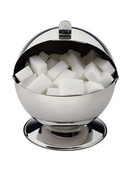
MONDAY, April 4 (HealthDay News) — People who are compulsive eaters show similar activity in the same brain regions as people who are addicted to drugs or alcohol, according to new research.
In particular, exposure to certain food “cues” — in this case, pictures of a chocolate milk shake — activated the brain’s reward circuitry.
“This confirms that addiction to food is tied into reward centers,” said Bonnie Levin, associate professor of neurology and director, division of neuropsychology at the University of Miami School of Medicine. “It’s a biologically driven process, not just a behavioral problem.”
Levin was not involved with the study, which appears online today and in the August issue of Archives of General Psychiatry.
This isn’t the first time scientists have seen clues that certain people may have a food addiction similar to substance dependence, especially since both drugs and food trigger the release of dopamine. However, this is the first time the correlation has been noted in people who actually qualify as “food addicts” on an accepted measurement of food addiction.
Here, about 40 healthy young women with body sizes ranging from lean to obese were first tested with the Yale Food Addiction Scale, then monitored with functional magnetic resonance imaging (fMRI).
Each woman was first shown a picture of a chocolate milkshake and an image of a glass of water.
They then were asked to actually taste the milkshake (four scoops of vanilla ice cream, 2-percent milk and 2 tablespoons of chocolate syrup) or a solution which tasted like natural saliva (plain water would have activated parts of the brain related to taste).
The researchers picked milkshakes not only because they have a high fat and sugar content (sugar has been most consistently linked with food addiction), but also because they could be consumed relatively smoothly through a small tube in the mouth. In contrast, chewing associated with candy bars or other forms of sweets would have caused the participants to move their head during the scan.
One hypothesis was borne out almost immediately: Women with higher food-addiction scores showed more activity in the parts of the brain associated with addiction when exposed to pictures of delectable chocolate milkshakes.
But, unexpectedly, when sampling the actual food, women showed less activation, which could be because “the brain just gets flooded all the time, which shuts down some of reward reactors,” explained study lead author Ashley N. Gearhardt, a doctoral candidate in clinical psychology at Yale University’s Rudd Center in New Haven. “You may think it’s going to be the best thing you ever tasted but it doesn’t meet expectations. That’s maybe why they eat more.”
In the study, the authors noted that one-third of American adults are now obese and obesity-related disease is the second leading cause of preventable death. They also explained that further research was necessary to clarify their results, pointing out, for example, that their study did not measure hunger (which could have an impact on the scores) and was confined only to females.
Despite some limitations, the researchers felt the specific nerve patterns of brain activation in some subjects suggested addiction, and were especially worried by the finding that mere images of food could start the brain racing.
“What I see as a bigger concern is really our food environment. If you think of these cues as starting to trigger the problem, the worst environment you could possibly be in is the one we have,” said Gearhardt. “All the billboards, all the vending machines. If you changed each of these into an alcohol cue and you were trying to recover from alcoholism, it would be impossible.”
“Advertising is everywhere and it exerts a powerful influence over our behavior. But it can have a positive impact, too, by helping people develop more successful self-control strategies, modulate food cravings and make healthier choices,” Levin said.
Another concern was that about 10 percent of people who didn’t necessarily qualify as food addicts also showed some activation in the related brain regions.
“Even though a small percentage might be full-blown food addicts, some may be showing subclinical symptoms like a lot of cravings,” Gearhardt said. “This could have a widespread cost on public health.”
Gearhardt is hoping that the study will spur the scientific community to accept food addiction as a disease, thereby reducing stigma among heavier people and leading to more effective ways for them to lose weight.
“We beat ourselves up in this society: ‘This is my fault,'” Gearhardt said. “When we finally decided to see alcohol having the potential to cause an addictive process, we stopped blaming people and started helping people.”
More information
For more on compulsive eating, visit Overeaters Anonymous.

